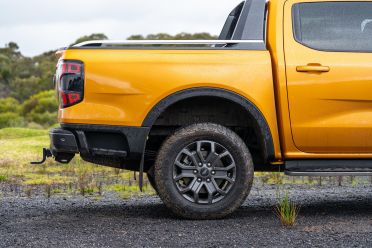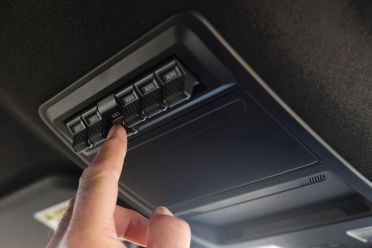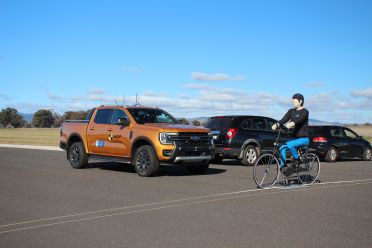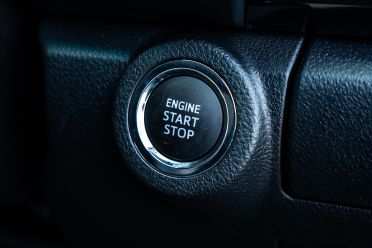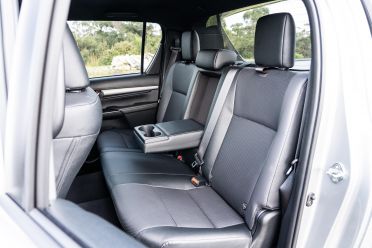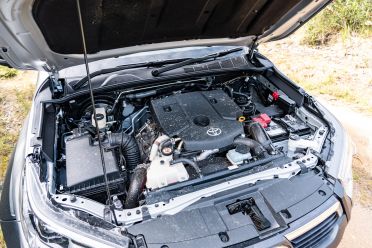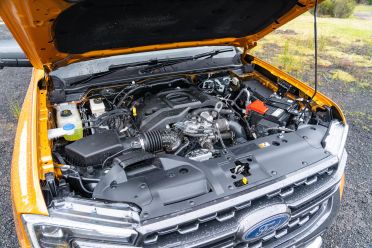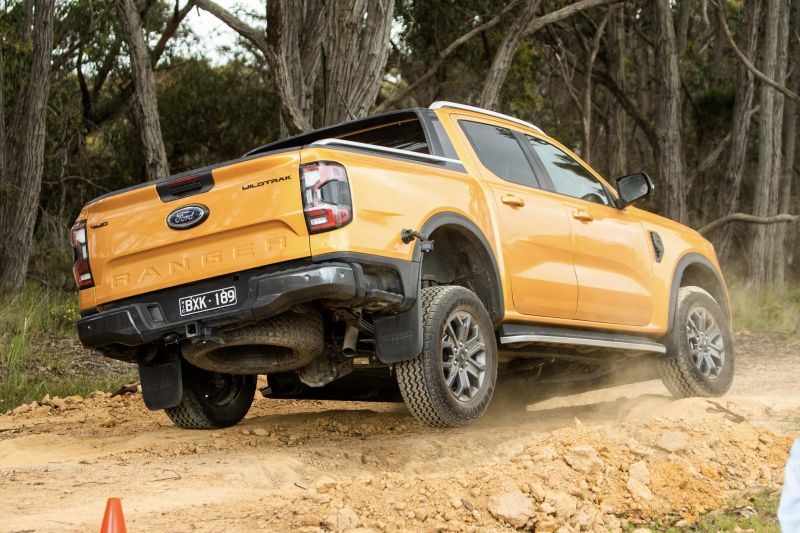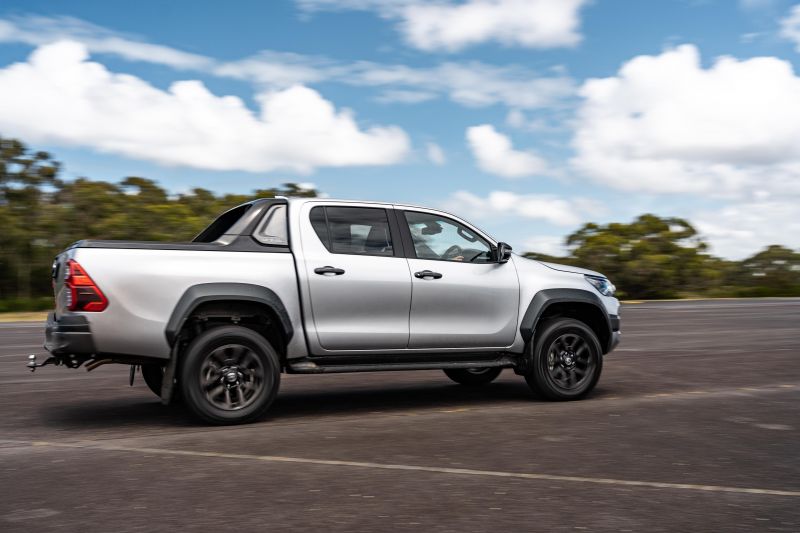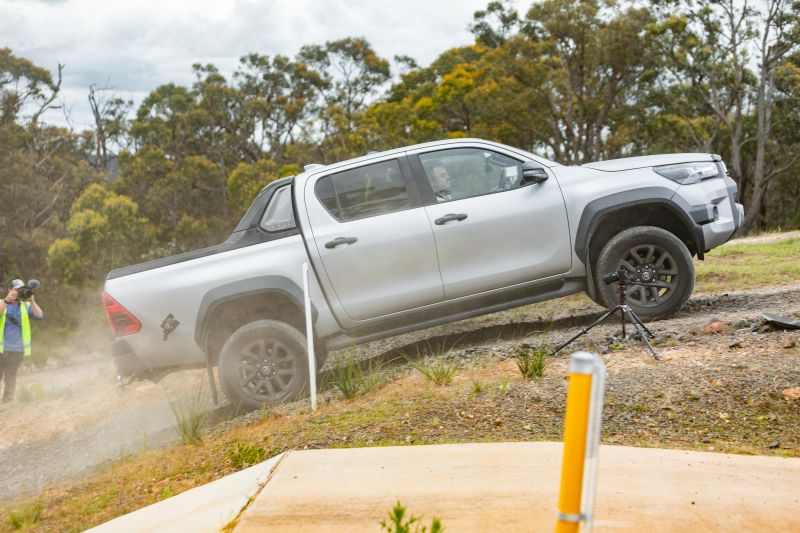This pair of luxury utes hardly need an introduction, given they are part of the two top-selling vehicle ranges in Australia.
The new-generation Ford Ranger has taken all before it since its 2022 launch, moving the dial in many ways and selling in greater numbers than Ford can supply.
But the Toyota HiLux is no slouch, and for thousands of people there’s simply no alternative to the Big T – irrespective of the competition’s quality.
Here we look at two highly specified versions, both of which come with list prices around $70,000 before on-road costs. Each is aimed at a more affluent ute buyer, often doubling as second family cars.
The Ranger Wildtrak was the top-of-the-range diesel variant at launch, but Ford has since launched the Ranger Platinum with more spec. With its potent V6 diesel and class-leading tech, it’s a formidable adversary for Toyota.
Meanwhile the range-topping (for now) HiLux Rogue launched last October with notable mechanical updates and some tough-looking fender flares. But at its core it’s a much older design, so does it show?
How much?
List prices
- Ford Ranger Wildtrak V6: $71,190
- Toyota HiLux Rogue: $70,200
Drive-away prices
- Ford Ranger Wildtrak V6: $76,600*
- Toyota HiLux Rogue: $74,995*
*Based on a Melbourne postcode
Both vehicles on test are unfortunately subject to wait times due to greater demand than supply. Your best bet is to search across multiple dealers.
What do you get?
The spec sheet for this pair is pretty similar as the prices suggest: both have 18-inch alloy wheels, LED lights, side steps, proximity key access, rear privacy glass, and parking sensors at both ends.
The Ranger has roof and tub rails, but the HiLux counters with a 220V outlet and cleaner sharkfin antenna. Note the Rogue’s brasher design with flared wheel arches that give it quite the stance – an attribute that’s hard to quantify.
Inside both come with rake-and-reach steering wheels, leather-accented and heated seats, powered driver’s seats, dual-zone climate control, carpet floors with mats, satellite-navigation, Apple CarPlay and Android Auto (wireless in Ford only), 360-degree cameras, and digital radio.
The Ford adds a powered front passenger’s seat, wireless phone charger, and rain-sensing wipers too. See our embedded Flourish tables below comparing most key features.
Options:
The Ranger Wildtrak cab be ordered with the $1850 Premium Pack which adds six auxiliary switches, Matrix LED headlights and tail lights, and an upgraded Bang & Olufsen sound system with 10 speakers (vs the HiLux’s nine). You can also add 20-inch wheels for $500.
Both also come with huge accessory catalogues, Ford’s including a bunch of ARB stuff and Toyota’s relying on in-house-developed add-ons. Premium paint costs $675 on the HiLux and $700 on the Ranger.
Tubs
Both brands have gone to town on these tubs, adding all sorts of lifestyle-focused modifications.
In the case of the Ranger there’s that grey ‘sport hoop’, preset mounting points and rails along the top of the tub, a powered roller shutter, sliding tie-downs mounted on rails, the unique rear-bumper box step, a quality bed liner, zone lighting, and a lightweight tailgate.
The HiLux likewise eschews a steel bar in favour of an apparently ‘sporty’ design hoop, and adds its own party tricks in the form of marine grade carpeting which is great for many things (that aren’t soil or mulch), a motorised roller cover, and lighting.
In both cases the powered roller covers take up a chunk of space, so it would be wise to check them out first. In its new generation the Ranger’s tub became a smidgen wider between the arches than the HiLux, and can swallow a standard pallet.
Likewise the Ford has a sizeable payload advantage at 997kg versus 794kg for the Toyota. Unsurprisingly the Ranger V6’s gross vehicle mass (GVM) of 3350kg is some 300kg greater than the HiLux’s (3050kg).
Are they safe?
Both vehicles tick the right fleet OH&S boxes with five-star ANCAP scores.
The Ford Ranger’s five-star result is from 2022 and includes a score of 84 per cent for adult occupant protection, 93 per cent for child occupant protection, 74 per cent for vulnerable road-user protection, and 83 per cent for safety assist features.
The Toyota HiLux’s five-star result is from 2019, meaning its tests were under earlier protocols. The result includes a score of 96 per cent for adult occupant protection, 87 per cent for child occupant protection, 88 per cent for vulnerable road-user protection, and 78 per cent for safety assist features.
Both are equipped with most core functions such as dual front, front-side, two-row curtain, and driver’s knee airbags, as well as rear-seat ISOFIX and top tether anchors.
Active driver-assists in both include autonomous emergency braking, blind-spot monitoring, rear cross-traffic alert, adaptive cruise control, front/rear parking sensors, and a 360-degree camera view.
But the Ranger’s lane-keeping aid is more advanced, it adds an assisted parking aid, and has two extra airbags (front passenger knee and front-centre to assist in head clashes upon side impact).
What are they like inside?
Ford Ranger Wildtrak
The Ranger’s steering wheel now offers telescopic adjustment unlike the old model, which improves ergonomics right off the bat. Like the HiLux it comes with a proximity key fob and a starter button – in the Ford’s case on the steering column.
Behind it sits a fully digital instrument cluster that can display speed, trip data, driver-assist settings, off-road pitch and roll angles, and real-time driveline animations. A flashier touch is the slick animated start sequence upon entry.
The 12.0-inch centre touchscreen is well ahead of any ute competitor at this price point, in terms of sheer real estate, but also quality and detail. Ford’s latest Sync system is easy to operate, with intuitive menus and a better voice-controlled assistant.
The satellite-navigation offers fantastic 3D graphics if you want them and pulls down real-time traffic alerts, and the Bluetooth re-paired quickly upon re-entry. On a side note you can also access the full vehicle manual with neat displays in the touchscreen.
Both vehicles here have a 360-degree camera display, but the Ford’s has greater clarity and therefore detail than the Toyota’s – something that becomes clear when parking, hitching a trailer, or cresting a hill with limited visibility.
The infotainment system also has an embedded modem for app-based remote connectivity, and eventual over-the-air updates. There’s also a USB outlet mounted next to the rear-view mirror for dash cam fitment.
While there is a digital climate control menu usually visible on the lower portion of the screen, Ford chose to retain buttons for certain controls (temperature, fan speed and recirculation) as well as audio volume, which is good when your hands are dirty.
Underneath the centre dash lies a phone-sized open cubby with a wireless charger – essential for the wireless Android Auto and Apple CarPlay functions, with near full-screen sizing – plus both USB-A and USB-C points.
The Ranger Wildtrak’s centre tunnel sports the electric park brake switch, which frees up space, behind which sits a rotary shifter to operate the 4×4 modes. The gear ‘e-shifter’ is better than a dial, but might take a few goes for some folks to adjust to.
Storage options include a capacious cupholder and glovebox, door bins for bottles and folders, and a phone-friendly backlit open section ahead of the front passenger. The Wildtrak brings a second, higher-mounted glovebox and cup holders along the dash too.
In terms of build quality the balance of padded, brightly stitched touchpoints and easier-to-clean hard surfaces felt about right, though the plastic pieces on the steering column were already coming loose and the centre console showed some sideways movement when shaken.
The back seats will house a pair of bigger adults well enough – I’m 194cm and was at the upper limits in term of head- and legroom – and it should prove a solid second family car since there are curtain airbags and ISOFIX and top-tether child-seat points.
Rear occupants get air vents, a 12V socket, spring-loaded pull-out roof handles, a flip-down centre armrest, and pull-up grab handles on each b-pillar. The backrest folds down, and you flip up the bench seat base to access hidden plastic storage bins.
Toyota HiLux Rogue
The HiLux’s steering wheel also adjusts for rake and reach, and the starter button is mounted near your right knee. It’s trimmed in harder-wearing material than the Ranger’s wheel is, with the trade-off being a less premium feel.
There’s a more conventional analogue (blue-lit) instrument cluster, one positive of this being a more legible tachometer than the Ranger’s. There’s a smaller screen between the gauges with a digital speedometer, and other vehicle data. But it doesn’t look as swish as the Ford’s.
One area where the HiLux really shows its age is its touchscreen, which is 50 per cent smaller diagonally than the Ford’s. It also doesn’t let you pinch and swipe as naturally as the Ranger’s more tablet-like display, and its graphics look older.
It still offers sat-nav and (wired) Apple CarPlay and Android Auto, as well as a 360-degree camera view. However, it is pretty low-resolution and thereby less useful than the Ford’s display when parking or hitching up a trailer.
The nine-speaker uprated sound system is also a noteworthy addition.
There are no climate controls buried in the screen, with a series of dials and switches instead, and it has to be said that Toyota’s A/C is elite.
Underneath the centre dash lies a phone-sized open cubby but there’s no wireless charger – and just the single USB-A point. That said, there are two 12V sockets ready for an adaptor if you need to charge more devices.
Unlike the Ford, the Toyota has an older school mechanical manual hand brake which many folks prefer. Another more analogue switch is the old-school 4×4 dial that enables on-the-fly switches between rear-wheel drive and locked 4×4. It’s all instantly familiar.
Storage options include two (stacked) lidded gloveboxes, a padded-lid console, door bins for bottles and folders, and high-mounted cupholders along the dash.
In terms of build quality, it all feels super-sturdy and tight. There’s too much piano black trimming but otherwise all the materials are basic, easy to clean and tough. It’s far from luxurious, rather it feels utilitarian with some slightly fancy touches.
Like the Ranger, the HiLux’s back seats can house a pair of adults well enough, and should prove a solid second family car since there are curtain airbags and ISOFIX and top-tethers.
Rear occupants get air vents, a flip-down centre armrest, and pull-up grab handles on each b-pillar. One criticism is the fixed grab handles, which sit right at forehead height and clearly pose an issue under heavy braking.
What’s under the bonnet?
The Ford actually comes with two diesel engines, with the larger and more expensive V6 tested here. The 3.0-litre turbo-diesel makes 184kW of power and 600Nm of torque, and is mated to a 10-speed automatic transmission and a full-time 4WD system with low-range.
If you want to save a few pennies and take delivery earlier, there’s also the 2.0-litre BiTurbo four-cylinder diesel with 154kW and 500Nm, plus a 10AT and part-time 4×4 – meaning there’s no open mode suited to slippery tarmac. Both engines are rated to tow 3.5 tonnes.
Meanwhile the Toyota HiLux uses a familiar 2.8-litre four-cylinder diesel with 150kW and 500Nm (down 34kW and 100Nm on the Ford), a six-speed automatic transmission, and part-time 4WD system with low-range. On paper it’s looking outdated next to the Ranger.
Both models have 80 litre diesel tanks, with the Ford’s ADR-tested combined cycle fuel consumption 7 per cent worse in exchange for 23 per cent greater power output.
How do they drive?
Ford Ranger Wildtrak
The Ranger’s 3.0-litre V6 diesel engine is a real advantage in this class. It’s not neck-snapping off the mark, but its smooth and linear responses lend confidence when hitting the accelerator hard for an overtake or lugging a trailer up a hill.
It certainly feels more responsive than the HiLux’s 2.8-litre four-cylinder, and stays that way as you climb toward the redline.
Our zero to 100km/h time on the Vbox in the Ranger V6 was 8.2 seconds, compared to 10.7 seconds for the HiLux. The Ford’s 80-120km/h time of 6.7 seconds was 20 per cent quicker than the Toyota’s 8.2 seconds too, quantifying that more muscular seat-of-the-pants feel.
We also towed a 2.5-tonne trailer with both, accelerating from standstill towards 100km/h, and the Ranger was about two seconds quicker. This pairs nicely with the integrated brake controller and the blind-spot monitor’s ability to change its width of views to suit long and wide trailers – controlled via a touchscreen menu.
The Ranger’s 10-speed automatic on the face of it seems like a recipe for a busy transmission, compared to the sensible six-speed unit in the HiLux, but the Ford has a narrower peak torque band than the HiLux and the shifts generally felt pretty decisive.
The Ford’s transmission defers to higher gears as quickly as it can to save fuel, but drops down a gear relatively responsively when you need a bit more grunt. There’s a hint of spooling lag if you hit the accelerator after lifting off, but it’s kept minimised by workhorse standards.
We only met the combined-cycle ADR fuel consumption claim under highway conditions. Yet since our test car was built it averaged a frankly quite reasonable 10L/100km – including taxing activities such as off-roading, towing and accelerator tests, as well as commutes.
Another boon is the full-time four-wheel drive system (just turn the dial to ‘4A’) which sends traction where it’s needed, meaning you can drive on sealed roads with four-wheel drive operational. This makes it surefooted in the wet, and gets rid of tyre chirping on sharp take-offs.
Ford still offers a traditional 2H and a 50:50 4H mode as well, but the set-and-forget 4A is just easier. It can also decouple the front wheels to save fuel – something you can watch happening live in the animated infographic in the digital cluster.
In terms of road manners, if there’s a mid-sized ute than truly offers SUV-like qualities, it’s the new Ranger. Thank the fact it’s designed and developed right here by Ford Australia, using local conditions.
While the core ladder frame and coil front/leaf rear suspension setups are familiar, Ford Australia’s engineers added 50mm in track width and moved the dampers outboard, theoretically tamping down ever further on hopping and bouncing when lightly laden.
Its suspension feels very composed over high speed bumps in terms of the way it absorbs and then settles the vehicle even without a load of tools, while it’s similarly effective at filtering out sharper hits such as potholes or gravel corrugations.
In town or off-road the lighter electric power steering is also a Ranger advantage, as are the stability and handling benefits of the permanent 4WD. Ford’s new EPAS seems to offer a little more directness and consistency to it than the previous generation.
It’s also quieter in terms of the degree to which tyre roar, wind noise, and engine gruffness enter the cabin at cruise. On the subject of refinement, the V6 also comes with fuel-saving stop/start that makes the vehicle quieter in urban surrounds when active.
Carting a payload of 600kg made little difference in terms of seat feel, aside from controlling post-bump rebound slightly more and requiring slightly earlier braking – from discs all-round on higher grade Rangers like this one.
Off the beaten path, the Ranger Wildtrak comes with conventional low-range gearing as well as hill-descent control, plus a locking rear diff. There are also a few new driving modes to select.
Mud/Ruts and Sand prime the driveline and traction control for loose surfaces and activate the rear diff lock, while the Tow/Haul mode tweaks the transmission’s shift timing to better suit towing, keeping lower gears more often to maximise pick-up and engine braking for example.
There’s a button that takes you to an off-road touchscreen menu, which houses driveline animations, steering angle and pitch/roll monitors, and a forward-view camera that’s great when you’re cresting a steep hill.
Our off-roading comprised a slippery 50-degree downhill piece of mud-covered asphalt in drive and reverse – in which the hill descent control with wheel-based speed adjustments proved smooth – as well as numerous rocks, muddy offset moguls, and hills.
It basically walked over everything we threw at it, but more impressively, its modes and menus all came across as user-friendly and will be far more accessible to someone who may not usually be a 4×4 enthusiast.
Toyota HiLux Rogue
The HiLux’s four-cylinder engine offers 34kW and 100Nm lower outputs than the Ford, though its peak torque is tuned to kick in lower and last across a wider part of the rev band. Of course, it’s much closer to the Ranger BiTurbo’s outputs of 154kW and 500Nm.
The Toyota’s 2.8-litre not quick, in fact it was about two-and-a-half seconds slower off the mark to 100 next to the Ranger, and 20 per cent slower from 80-120km/h. It’s tractable and does the job, but it lacks the Ranger’s firepower.
We also towed a 2.5-tonne trailer with both, accelerating from standstill towards 100km/h, and the Ranger was decidedly quicker to get to cruising speed. To Toyota’s credit the Rogue comes with a towbar, towball and tongue, and a seven-pin flat trailer wiring harness.
The HiLux’s six-speed automatic is a pretty simple setup but doesn’t need to be all that busy given the wide torque band. It’s also more intuitive if you want to override the shifts: push forward to upshift, pull for downshift, against the Ford’s fiddly buttons on the side of the shifter.
It also proved to be no more fuel efficient than the Ford, with our average being 10.2L/100km. We also noted the diesel particulate filter burned off more regularly than the Ford’s once we were cruising at the right operating temperature.
The HiLux has a more traditional part-time 4×4 system (as does the BiTurbo Ford Ranger four-cylinder) compared to the Ranger V6’s full-time 4WD mode. That means you’re always running rear-wheel drive on sealed roads.
While the HiLux has a reputation for riding badly at the rear when unladen, Toyota’s Australian tuners have done great things to improve it. It’s not quite as plush and quick to settle as the Ford in my opinion, but it’s still damn good at barrelling down a corrugated b-road.
While the HiLux’s development program isn’t as ‘Australian-ised’ as the Ranger, there’s still substantial local engineering involved.
The Toyota runs coil suspension at the front and a leaf-sprung solid axle at the rear. But the Rogue gets some bespoke changes led by a wider track and an additional 20mm of ride height, from updated springs.
Toyota extended the length of the front suspension arm and front stabiliser bar, and changed the front damper angle. Moreover the rear axle is lengthened, the rear dampers moved towards the wheels, and a rear stabiliser is present.
It feels pretty stable and assured in more spirited driving and on gravel, with better directional changes than many other commercials and a well-tuned stability control. It’s not quite as unruffled as the Ranger but it’s close.
There’s a greater amount of difference in the steering, with the hydraulic HiLux’s feeling weightier and more communicative, for good (road feel) and bad (shaking over corrugations).
Carting the same payload as the Ford made little difference in terms of seat feel, though just remember that lower payload. Stopping power is improved by the fitment of rear ventilated disc brakes in place of drums – yes the front brakes do most of the work, but better is better.
There’s no doubt the HiLux is damn good off-road, and more conventional in its controls: part-time 4×4, a simple mechanical switch to engage 4H and 4L, and excellent low-down tractability. Note also the HiLux has about 30mm more ground clearance.
It doesn’t match the Ranger’s tricky traction modes, animated diagrams and high-res cresting camera, but for a 4×4 enthusiast it’ll go anywhere.
As with the Ranger our off-roading comprised a slippery 50-degree downhill piece of mud-covered asphalt in drive and reverse – in which the hill descent control with wheel-based speed adjustments proved smooth – as well as numerous rocks, muddy offset moguls, and hills.
Cost of ownership
Both Ford and Toyota provide five-year factory warranties with no mileage limit. But there is a key difference between the two, namely service intervals.
Ford’s service intervals are 12 months or 15,000km, with the below prices over four years. Toyota’s service intervals on the other hand are just six months or 10,000km. This means the Ford should be cheaper to service for most people.
Ford Ranger
- 12 months or 15,000km: $329
- 24 months or 30,000km: $329
- 36 months or 45,000km: $329
- 48 months or 60,000km: $329
Toyota HiLux
- 6 months or 10,000km: $290
- 12 months or 20,000km: $290
- 18 months or 30,000km: $290
- 24 months or 40,000km: $290
- 30 months or 50,000km: $290
- 36 months or 60,000km: $290
- 42 months or 70,000km: $332
- 48 months or 80,000km: $750
Connected services
The FordPass app can be used to lock, unlock and remotely start the vehicle; check fuel level, tyre pressures and oil life; find the car on a map; check the odometer; and remotely turn on the exterior projector lighting. You can access 24/7 roadside assist and dealer contacts too.
There’s also a very thoughtful Trailer Light Check feature: hook up your trailer including cables, stand behind it, press a button, and it’ll run through the full light sequence (indicators, brakes, reverse lights), so you no longer need a mate or a reflective shed.
The HiLux is no slouch here either. It comes with an SOS emergency call function inside the vehicle that dials 000 when the airbags go off or impact sensors detect a crash.
You also get three years of Toyota Connected Services, meaning an app that lets you remotely check vehicle data such as odometer and fuel level, remind yourself where you’re parked, and track your vehicle if stolen. Not quite as good as FordPass then…
CarExpert’s Pick
It’s a pretty clear victory for the Ford Ranger Wildtrak here.
The HiLux may be marginally cheaper but the Ford has better engine performance, more comfortable road manners, superior interior technologies, more driver-assist features, and better servicing intervals.
The HiLux Rogue is probably a podium player with all things considered, which is in and of itself quite impressive, but the more advanced age of its design is starting to show.





